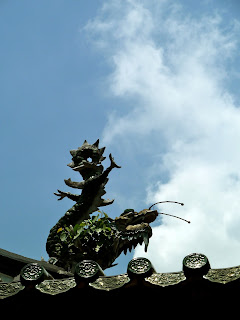Since I had the whole morning to myself, I decided to find my own way to Chinatown. There is no way I am not going to visit Chinatown (I think I will make it a point to visit the Chinatown of every city I travel to).
When I saw that sheltered pathway, I thought of Petaling Street (KL's version of Chinatown) and went, "Oh, so this was where KL stole the idea from!"
I also thought to myself, "Wow, their buildings are so much more well-maintained compared to our heritage buildings in KL!"
And of course, so much cleaner and more well-organised, as well!
Today's Chinatown comprises five districts: Telok Ayer, Bukit Pasoh, Tanjong Pagar, Kreta Ayer and Ann Siang Hill. Designated as conservation areas, these districts have over the years cultivated their own unique identity.
I tried to cover as much of the place as possible before I was due to meet Chee Kin. One place of interest I walked past was Sri Mariamman Temple, the oldest Hindu temple in Singapore.
I leisurely soaked in the mixture of historical and modern architecture as I fumbled my way to Ann Siang Hill.
Ann Siang Hill was named after Chia Ann Siang (谢安祥; 1832-1892), a wealthy Malacca-born Hokkien sawmiller who worked for the company now known as Boustead Singapore in 1848. The company traded in natural resources, spices, coconut, tobacco, tin, tea and silk. After 8 years on the job, Chia was promoted to chief produce storekeeper. He retired in 1890 after over 40 years of service in the company, and went into the timber business. He also became a partner of the firm Geok Teat and Company in 1863. After he became a wealthy landowner and one of the leading merchants of his time, he acquired both Ann Siang Hill and Mount Erskine. Before he bought the area, the hill was known as Gemmill's Hill after John Gemmill, a merchant and former auctioneer, and before that Scott's Hill, after its original owner Charles Scott, who cultivated nutmegs and cloves in the area.
| A lovely cafe at the top of the hill |
The Chinese used to call this area qing shan ting. The early Chinese immigrants visited Ann Siang Hill when they wanted to send money home to their families in China, as it was the traditional site of remittance houses. Letter writers and calligraphers also had their businesses at the five-foot way of the shophouses to help the illiterate immigrants write letters home.
Most of the houses in Ann Siang Hill and along Ann Siang Road were built between 1903 and 1941. Ann Siang Road, which has elegantly restored shophouses today, was once the traditional home of clan associations and exclusive social clubs.
Further down Telok Ayer Street was Al-Abrar Mosque, one of the earliest mosques in Singapore.
A few steps down the same street was Thian Hock Keng, one of the earliest of most important Hokkien temples in Singapore.
Built in 1839 in the southern Chinese architectural style, the entire structure was assembled without the use of nails.
Along the same street was another place of worship called Nagore Durgha Shrine. Apparently, the monument itself has changed very little since it was built in the 19th century, except for maybe some restoration work in 2007. In contrast, its surroundings have changed beyond recognition.
A place of worship for the Muslim Indians, I did not expect it to look like that. See how dangerous presumptions are? Resembling a multi-layered cake, it still had motives of the familiar Muslim crescent and star, though.
The final place I visited (or more like just take photos from the outside) was the Buddha Tooth Relic Temple and Museum near the MRT station.
It was massive and from the outset looked like it was recently built, unlike all the other temples, shrines and mosques above. It is open free to the public daily from 7:00am to 7:00pm.
Although I did not cover the whole of Chinatown, I felt that I did a pretty good job, though. Oh well, good reason to return, no?





















No comments:
Post a Comment